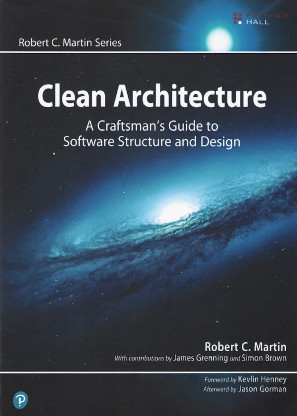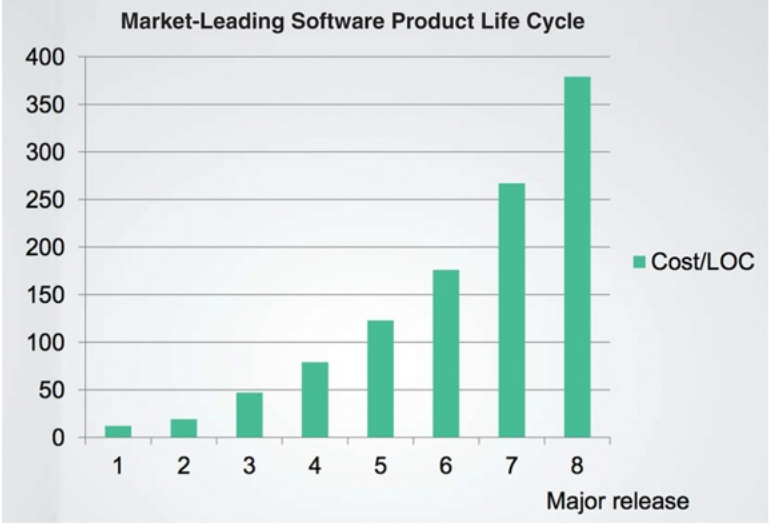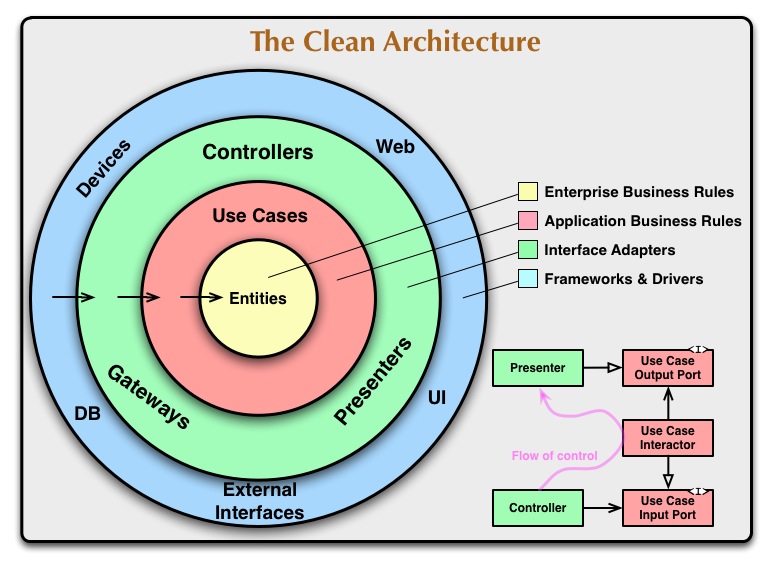Clean Architecture - book review
Posted on 18 May 2023 in Books • 6 min read
Oh, I loved the book! A warm picture emerges in my mind: late evening, comfortable armchairs, a hot burning fire in a fireplace, and an engaging discussion with a dear friend who happens to be one of the greatest teachers in software engineering...

"Clean Architecture" is the "Art of War" of the software industry. It was written by a professional who has been through many tough battles, both wins, and losses. Uncle Bob talks about timeless topics of software development that are just as applicable today as they were fifty years ago.
Software architecture determines the necessary pieces and their integration to create the desired system. The pieces can vary from individual variables and functions to large-scale services like databases.
The goal of software architecture is to minimize the human resources required to build and maintain the required system. The measure of design quality is simply the measure of the effort required to meet the needs of the customer.
It is that simple! Or is it? How many times have you struggled trying to fit a new feature into an existing code base? How many times have you started from scratch, only to find later that the redesign became the same mess as before?
Here is a scary diagram from the book. It shows how the cost of each line of code increases with every major release. This trend is not sustainable; no business model can make a profit while letting costs grow exponentially.

Why does this happen? What goes wrong? Too often, we developers buy into the familiar lie: "We can clean it up later; we just have to get to market first!"
Of course, things never do get cleaned up later, because market pressures never abate. Getting to market first simply means that you’ve now got a horde of competitors on your tail, and you have to stay ahead of them by running as fast as you can.
And so the developers never switch modes. They can’t go back and clean things up because they’ve got to get the next feature done, and the next, and the next, and the next. And so the mess builds, and productivity continues its asymptotic approach toward zero.
Making messes is always slower than staying clean and the only way to go fast, is to go well.
We often forget that, unlike firmware, software was invented to be "soft." It was intended to be a way to easily change the behavior of machines. Therefore, software architectures should be as shape-agnostic as possible. Uncle Bob argues that for a software system to be easy to change, it is more important than for it to work.
If you give me a program that does not work but is easy to change, then I can make it work, and keep it working as requirements change. Therefore the program will remain continually useful.
One of our responsibilities is to find the balance and assert the importance of architecture over the urgency of features. Sometimes we have to fight for it with the business side that is pushing to implement new features. If architecture comes last, then the system will become even more costly to develop, and eventually, change will become practically impossible for a part or all of the system.
That is the end of Part I - Introduction. The rest of the tale is for you to discover, just like in 'One Thousand and One Nights'.
Inside the book
In Part II - Starting with the Bricks: Programming Paradigms, Uncle Bob discusses structured, object-oriented, and functional programming paradigms, and how to apply them from an architectural perspective.
Each paradigm is about discipline, telling us what not to do, and each paradigm takes something away from us. Each restricts some aspect of the way we write code.
In Part III - Design Principles we learn to put the well-made software bricks together.
Good software systems begin with clean code. On the one hand, if the bricks aren’t well made, the architecture of the building doesn’t matter much. On the other hand, you can make a substantial mess with well-made bricks. This is where the SOLID principles come in.
The goal of the principles is the creation of mid-level software structures that:
- Tolerate change,
- Are easy to understand, and
- Are the basis of components that can be used in many software systems.
Part IV - Component Principles is about arranging larger software blocks to make a sound system.
Components are the units of deployment. They are the smallest entities that can be deployed as part of a system. In Java, they are jar files. In Ruby, they are gem files. In .Net, they are DLLs. In compiled languages, they are aggregations of binary files. In interpreted languages, they are aggregations of source files.
Regardless of how they are eventually deployed, well-designed components always retain the ability to be independently deployable and, therefore, independently developable.
We learn the principles that help in putting components together. We learn how to group and separate the components and how to manage dependencies between them.
Finally Part V - Architecture and Part VI - Details. So far the book has been preparing us to grok these parts.
The architecture of a software system is the shape given to that system by those who build it. The form of that shape is in the division of that system into components, the arrangement of those components, and the ways in which those components communicate with each other.
Uncle Bob talks about the importance of deferring decisions about details. Should we use a database or a plain text file? Shall we rely on TCP or UDP? Do we use React, Vue, or Angular? He argues that the longer we keep our options open, the more information we can gather and the more experiments we can conduct to make an informed decision.
The architecture that allows us to delay these decisions establishes clear boundaries between its components.
Software architecture is the art of drawing lines that I call boundaries.
This statement leads the way to Clean Architectures, which are
- Independent of frameworks. The architecture does not depend on the existence of some library of feature-laden software. This allows to use such frameworks as tools, rather than forcing to cram system into their limited constraints.
- Testable. The business rules can be tested without the UI, database, web server, or any other external element.
- Independent of the UI. The UI can change easily, without changing the rest of the system.
- Independent of the database. We can swap out Oracle or SQL Server for Mongo, BigTable, CouchDB, or something else.
- Independent of any external agency. The business rules don’t know anything at all about the interfaces to the outside world.

Thoughts
This is one of the "must-read" for all software engineers. The only question is, "When?". This book discusses many abstract topics. Unless you are intimately familiar with software development, it may have little impact on you. However, when you start interacting with large systems, a time comes when you sense that something is wrong, and you can't simply formalize it. That's when you know the time has come. The time to do architecture right. The time to embrace Clean Architecture.